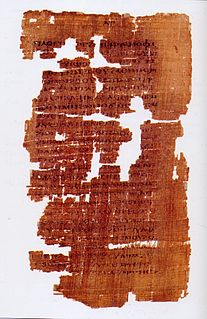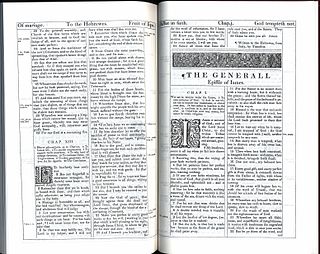
The Epistle of Paul to the Colossians, often referred to simply as Colossians, is the twelfth book of the New Testament. It was written, according to the text, by Paul the Apostle and Timothy to the Church in Colossae, a small Phrygian city near Laodicea and approximately 100 miles (160 km) from Ephesus in Asia Minor.

The First Epistle to the Thessalonians, usually referred to simply as First Thessalonians, is the thirteenth book from the New Testament of the Christian Bible. The first letter to the Thessalonians was likely the first of Paul's letters, probably written by the end of AD 52.

The Epistle to the Romans or Letter to the Romans, often shortened to Romans, is the sixth book in the New Testament. Biblical scholars agree that it was composed by the Apostle Paul to explain that salvation is offered through the gospel of Jesus Christ. It is the longest of the Pauline epistles.

The Second Epistle to the Thessalonians, often referred to as Second Thessalonians (US) or Two Thessalonians (UK) is a book from the New Testament of the Christian Bible. It is traditionally attributed to Paul the Apostle, as it begins, "Paul, Silvanus, and Timothy, To the church of the Thessalonians" and ends, "I, Paul, write this greeting in my own hand, which is the distinguishing mark in all my letters." Modern biblical scholarship is divided on whether Paul was the author or not; many scholars question its authenticity based on what they see as differences in style and theology between this and the First Epistle to the Thessalonians.

The Pauline epistles, Epistles of Paul, or Letters of Paul, are the thirteen books of the New Testament, composed of letters which are largely attributed to Paul the Apostle, although authorship of some is in dispute. Among these letters are some of the earliest extant Christian documents. They provide an insight into the beliefs and controversies of early Christianity. As part of the canon of the New Testament, they are foundational texts for both Christian theology and ethics. The Epistle to the Hebrews, although it does not bear his name, was traditionally considered Pauline for a thousand years, but from the 16th century onwards opinion steadily moved against Pauline authorship and few scholars now ascribe it to Paul, mostly because it does not read like any of his other epistles in style and content. Most scholars agree that Paul really wrote seven of the Pauline epistles, but that four of the epistles in Paul's name are pseudepigraphic ; scholars are divided on the authenticity of two of the epistles.

Pauline Christianity or Pauline theology is the Christianity or theology associated with the beliefs and doctrines espoused by Paul the Apostle through his writings. Nicene Christianity relies heavily on these teachings and considers them to be amplifications and explanations of the teachings of Jesus. Others perceive in Paul's writings teachings that are different from the original teachings of Jesus documented in the canonical gospels, early Acts and the rest of the New Testament, such as the Epistle of James.

The Third Epistle to the Corinthians is a pseudepigraphical text under the name of Paul the Apostle. It is also found in the Acts of Paul, and was framed as Paul's response to the Epistle of the Corinthians to Paul. The earliest extant copy is Papyrus Bodmer X, dating to the third century. Originally written in Greek, the letter survives in Greek, Coptic, Latin, and Armenian manuscripts.

The Pauline epistles are the fourteen books in the New Testament traditionally attributed to Paul the Apostle, although many dispute the anonymous Epistle to the Hebrews as being a Pauline epistle.

Frederick Fyvie Bruce, usually cited as F. F. Bruce, was a biblical scholar who supported the historical reliability of the New Testament. His first book, New Testament Documents: Are They Reliable? (1943), was voted by the American evangelical periodical Christianity Today in 2006 as one of the top 50 books "which had shaped evangelicals".

Count Carlo Ottavio Castiglioni (1784-1849) was an Italian philologist and numismatist.
The Lost Books of the Bible and the Forgotten Books of Eden (1926) is a collection of 17th-century and 18th-century English translations of some Old Testament Pseudepigrapha and New Testament Apocrypha, some of which were assembled in the 1820s, and then republished with the current title in 1926.

The Epistle to the Hebrews of the Christian Bible is one of the New Testament books whose canonicity was disputed. Traditionally, Paul the Apostle was thought to be the author. However, since the third century this has been questioned, and the consensus among most modern scholars is that the author is unknown.

The canon of the New Testament is the set of books Christians regard as divinely inspired and constituting the New Testament of the Christian Bible. For most, it is an agreed-upon list of twenty-seven books that includes the Canonical Gospels, Acts, letters of the Apostles, and Revelation. The books of the canon of the New Testament were written before 120 AD.

A Protestant Bible is a Christian Bible whose translation or revision was produced by Protestants. Such Bibles comprise 39 books of the Old Testament and the 27 books of the New Testament for a total of 66 books. This is often contrasted with the 73 books of the Catholic Bible, which includes seven deuterocanonical books as a part of the Old Testament. The division between protocanonical and deuterocanonical books is not accepted by all Protestants who simply view books as being canonical or not and therefore classify the seven Catholic deuterocanonical books as part of the Apocrypha.

Romans 1 is the first chapter of the Epistle to the Romans in the New Testament of the Christian Bible. It is authored by Paul the Apostle, while he was in Corinth in the mid 50s CE, with the help of an amanuensis (secretary), Tertius, who adds his own greeting in Romans 16:22. Acts 20:3 records that Paul stayed in Greece, probably Corinth, for three months.
The International Critical Commentary is a series of commentaries in English on the text of the Old Testament and New Testament. It is currently published by T&T Clark, now an imprint of Bloomsbury Publishing.

The following outline is provided as an overview of and topical guide to the Bible:










